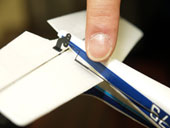|
■Newly developed 2.4GHz R/C System

WEB:
The normal weight for a micro-servo is about 6g, and as you wanted full control functionality, at least two servos are needed. In addition, there is the motor control amp and battery for the receiver, plus the fuselage and linkage parts etc. How on earth did you do it?

Hamazaki:
 |
| We used carbon and piano wire for linkage rods etc. and the outcome was a precision lightweight airplane with great slow flight capability. |
|
It was a real challenge to say the least. To achieve the total weight target, we looked at each individual component and found there was nothing available that met our needs. So we decided to design everything from scratch. From the project start date, one year flew by and it wasn't until the 2nd year that we started to make real progress and finally take it to production. |
 |
WEB:
After 2 years in development, I am sure people will want to read about all the features, but the new R/C system in particular is attracting plenty of interest.

Hamazaki:
The R/C system was designed completely from scratch. We first tried existing 27GHz technology, but the weight of the receiver, amp and servo couldn’t be achieved below 7g. Then we thought about trying 2.4GHz. Well known as a Bluetooth frequency, it allowed us to make the receiver unit really small. As it wouldn’t interfere with any existing R/C models, it also allowed many 2.4GHz airplanes to fly at the same time. The same frequency could also be used in many different countries. We knew this was the technology we needed, but as this was its first application in R/C, it wasn’t always easy.
|